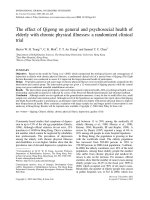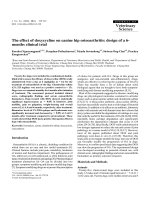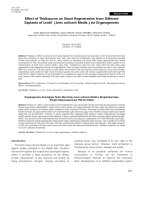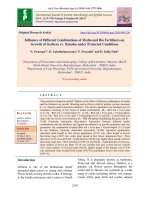A review: Effect of fertigation on bell pepper grown under protected conditions
Bạn đang xem bản rút gọn của tài liệu. Xem và tải ngay bản đầy đủ của tài liệu tại đây (121.57 KB, 5 trang )
Int.J.Curr.Microbiol.App.Sci (2019) 8(5): 2157-2161
International Journal of Current Microbiology and Applied Sciences
ISSN: 2319-7706 Volume 8 Number 05 (2019)
Journal homepage:
Review Article
/>
A Review: Effect of Fertigation on Bell Pepper Grown
under Protected Conditions
Amit Saurabh1* and Sukhjinder Singh2
Department of agriculture Baba Farid College, Baba Farid Group of Institutions,
Deon Bathinda, India
*Corresponding author
ABSTRACT
Keywords
Protected
Fertigation,
Irrigation
Article Info
Accepted:
17 April 2019
Available Online:
10 May 2019
The Sweet pepper is one such vegetable known to possess many nutritional qualities and
commercially being grown under the protected conditions. An important component of
protected cultivation which influences productivity and quality of produce is application of
fertilizers with the irrigation called fertigation. This is a regular and widely accepted
practice under protected conditions. Fertigation also provides an opportunity to control the
concentrates of individual nutrients in the form of soluble fertilizers to meet the crop need
according to its stage of development and greenhouse environment. Hence, to obtain good
quality produce and more production per unit area with efficient resource management, the
practice of growing crops under protected conditions will be a boon to the small and
marginal farmers. So cultivation of bell pepper under protected structure with fertigation
leads to higher yield, better quality, higher benefit cost ratio. So will recommend the
farmers to cultivate the bell pepper under protected conditions along with fertigation as it
is going to increase their income many times.
Introduction
Vegetable crops are becoming an important
alternative in diversification of agriculture
and also playing a significant role in food,
nutritional and health security of ever
growing population in India. The Sweet
pepper (Capsicum annuum L. var. grossum
Send t; 2n = 24) also known as bell pepper,
belonging to family Solanaceae and a native
of Mexico with secondary center of origin in
Guatemala (Heiser and Smith, 1953), is one
such vegetable known to possess many
nutritional qualities. Recently with the change
in the food habits of the people of the country
especially major cities, a scope for growing of
many vegetables and their varieties which are
generally consumed as raw and are very good
source of nutrition, has emerged. These
varieties are available in different colours
which are nutritionally very rich especially in
vitamins particularly A and C. (Anon., 2001).
The cultivation of such varieties requires
more advanced techniques for their improved
production and good quality of the produce.
Growing of these crops under protected
conditions is one such specialized way of
2157
Int.J.Curr.Microbiol.App.Sci (2019) 8(5): 2157-2161
farming. Such technology can also be utilized
for control of environmental parameters such
as temperature, relative humidity, light
intensity, light reduction, CO2 level,
irrigation, nutrient supply and uptake, training
stems, growing medium and controlling
fertilization schedules that are essentially
required for optimum plant growth and higher
yields with good quality harvests (Baghel et
al., 2003).
The major agrotechnique which are largely
important in greenhouse crop production is
the optimum fertigation schedule. Important
component of protected cultivation which
influences productivity and quality of produce
is application of fertilizers with the irrigation
called fertigation. This is a regular and widely
accepted practice under protected conditions.
Fertigation also provides an opportunity to
control the concentrates of individual
nutrients in the form of soluble fertilizers to
meet the crop need according to its stage of
development and greenhouse environment.
Hence, to obtain good quality produce and
more production per unit area with efficient
resource management, the practice of growing
crops under protected conditions will be a
boon to the small and marginal farmers.
Effect of
characters
fertigation
on
quantitative
Gowda et al., (2002) observed that the
maximum plant height, number of branches
per plant, leaf area and dry matter production
per plant were recorded in plant supplied with
75 per cent nitrogen, phosphorus plus 100 per
cent potassium in addition to the inoculation
of Azotobacter, Azospirillum, PSB and VAM.
Besides, the same treatment recorded more
number of fruits per plant, fruit length, fruit
girth, number of seeds per fruit, dry weight of
hundred fruits and higher yield of dry chillies.
The maximum TSS, ascorbic acid, oleoresin
and capsaicin content in dry chillies was also
at this level. Application of bio-fertilizers
along with reduced levels of chemical
fertilizers has beneficial effects as compared
to application of recommended NPK or biofertilizers alone.
Highest benefit
Cost ratio of 2.17 was reported by Tumbare
and Bhoite (2002) when N, P, K water soluble
fertilizers were applied as fertigation, through
drip irrigation system in capsicum.
Studies on the application of different
nitrogen and potassium doses on pepper crop
grown under plastic tunnels and field
conditions were carried out by Santos et al.,
(2003) and the results showed that greenhouse
plants exhibited 98, 278, 119, 67 and 92 %
increase in height, leaf area, leaf dry matter,
green fruit number and fruit production,
respectively. The doses of water soluble
fertilizers also influenced growth and fruit
production.
Olaniyi and Ojetayo (2010) recorded the
growth parameters such as plant height and
number of leaves showed increasing response
to all the treatments as the rates increased.
The optimum yield of pepper was obtained
from sole application of NPK at 250 kg NPK
ha-1.
Similarly, Ciba (2011) observed that drip
fertigation with 100 per cent water soluble
fertilizer along with Bio stimulants recorded
highest plant height, number of primary and
secondary branches, number of flowers/plant
and yield and component characters. In 2011,
Malik et al., conducted an experiment and
observed that the treatments comprising of
N=150 kg/ha, P2O5 = 120 kg/ha, K2O = 60
kg/ha with FYM = 40 t/ha proved better to
improve the growth and yield attributing traits
than other treatment combinations.. This
treatment also exhibited higher vitamin C
2158
Int.J.Curr.Microbiol.App.Sci (2019) 8(5): 2157-2161
(243.34 mg/100 g), dry matter content (9.93
g/100 g) and nitrogen (4.38 %), Phosphorus
(0.46 %) and potassium (3.65 %) in fruit.
during summer and kharif respectively. The
TSS of capsicum fruits did not differ
significantly.
Similarly, Sabli et al., (2012) observed that
fertigation with N and K gradually increasing
from 126.10 to 265.21 and finally 385.32
mg/L (treatment 1) increased fruits of Bell
Pepper significantly by 8 % over the control.
Higher yield in treatment 1 was associated
with the higher leaf area, total dry matter
production, number of fruits/plant and higher
fertilizer use efficiency.
An experiment was also conducted by Shetty
and Manohar in 2008 and observed that the
application of 25% N through Pongamia
cake+75% RDF+25t /ha farmyard manure + 5
g Azotobacter/plant significantly increased
the growth parameters, i.e. plant height
(64.72, 127.34 and 225.93 cm), number of
branches per plant (12.47, 18.21 and 20.57)
and plant spread (448.24, 981.31 and 1250.10
cm2) when observed at 60, 90 and 120 days
after
transplanting,
respectively.
The
capsicum plants responded significantly to the
integrated nutrient supply.
Bhuvneshwari et al., 2013 studied the effect
of nitrogen and potassium on growth and
yield of capsicum and observed maximum
plant height from 75kg N and 60 Kg K per ha.
Biwalkar et al., (2015) studied the
performance of coloured sweet pepper and
observed
that
treatment
combination
(fertigation 120%and irrigation 100%)
recorded the maximum fruit length, fruit
width and pericarp thickness.
Effect of fertigation on yield contributing
components
Studies on the application of different
nitrogen and potassium doses on pepper crop
grown under plastic tunnels and field
conditions were carried out by Santos et al.,
(2003) and the results showed that greenhouse
plants exhibited 67 and 92 % increase in
green fruit number and fruit production,
respectively. The doses of water soluble
fertilizers also influenced fruit production.
Similarly, an experiment was carried out by
Mantur et al., in 2007 the results revealed that
among nutritional sources, N2 recorded
significantly higher average fruit weight
(86.80g and 95.60g), fruit yield per plant
(750.50g and 937.10g) and fruit yield per m2
(3.04kg and 3.78kg) compared to N1 and N3
Similarly, Khan et al., conducted a field
experiment during 2010 and observed that
Plant height, number of branches and number
of fruits per plant increased significantly with
increasing nitrogen doses up to 100 kg N /ha.
However, plant height and number of
branches at final harvest increased
significantly up to 150 kg N/ ha (N3
treatment). On the other hand, plant height
and number of branches at first harvest
increased significantly with increasing levels
of P up to the treatment P1 (30 kg P/ ha),
whereas plant height and number of branches
at final harvest and number fruits per plant
enhanced significantly with the treatment P2
(60 kg P/ha). Considering the combined effect
of nitrogen and phosphorus, the maximum
plant height at final harvest were obtained
from N2P2 (100 kg N + 60 kg P /ha). On the
other hand, maximum number of fruits per
plant were found in the treatment combination
N3P1 (150 kg N + 30 kg P/ ha).
In 2010, Gupta et al., also conducted a study
on capsicum var Nishat 1 and the results
revealed that there was significant
improvement in yield, quality, water and
fertilizer use efficiencies of capsicum under
2159
Int.J.Curr.Microbiol.App.Sci (2019) 8(5): 2157-2161
drip irrigation and fertigation. The combined
effect was found superior than individual
effects. The treatment combination of 80 %
ET through drip and 80 % recommended
NPK through fertigation registered maximum
fruit yield (336.48 q/ha).
Obidiebube et al., (2012) recorded that The
Red pepper cultivar was significantly
different from other cultivars in yield with the
value of 256g/plant followed by cultivar, 40
FNHVIA with 168g/plant. Cultivar, 52
Zugande performed better than other cultivars
for the number of seeds per fruit. Similarly,
significant interaction effects between
fertilizer levels and cultivars of pepper were
observed for yield parameters. The interaction
of cultivar Red pepper and 360kg/ha level of
fertilizer produced the highest number of
fruits and the largest fresh weight per plant.
Red pepper proved to be superior over other
cultivars used and it may be recommended to
farmers in this agroecological zone.
Vinod Sharma (2016) recorded that
application of 50 % more of recommended
dose recorded significantly recorded higher
plant height fruit length fruit breadth fruits per
plant and fruit yield per plant than other level
of NPK. Rekha et al., (2017) recorded the
combined variance analysis indicated that
experimental season were not significantly
different but irrigation interval and nutrient
level both influenced the growth parameter
and total capsicum yield.
Mohamed Shahein et al., (2018) studied the
Impact of bio- and sources of organic
fertilizers on sweet pepper vegetative growth,
yield and quality under protected cultivation
condition. And observed that the Bio
fertilization gave significantly higher values
of vegetative growth, NPK concentration in
leaves and fruits and yield. Using organic
fertilizer leaded to the greater values of
vegetative growth, NPK concentration in
leaves and fruits, early yield, total yield, total
number of fruits per plot, and fruit length and
diameter as compared to the other sources of
organic manures The combined treatment
between compost and bio fertilization gave
the highest significant increase in vegetative
growth, NPK concentration in leaves and
fruits and yield whereas vitamin C and fruit
firmness were decreased by using compost,
bio fertilization alone or in combination.
References
Anonymous. 2001. Nutritive value of Indian
foods
/>nutritive, value.aspx
Baghel B, Gupta M and Tiwari R. 2003.
Potential and prospects of protective
cultivation of horticultural crops. Proc.
All India Sem. on Potential and Prospects
for Protective Cultivation, organized by
the Institute of Engineers, Ahmednagar,
December 12-13, 2003.
Bhuvneshwari G, Sivaryani R, Reeth S and
Ramakrishnan K. 2013. Application of
nitrogen and potassium efficiency on
growth
and
yield
of
chilli.
Int.J.Curr.Microbiolo.App.Sci.2(12):329337
Biwalkar Nilesh,KG Singh ,AK Jain,Rakesh
Sharda, SK Jindal, Kulbir Singh, Neena A
Chawla.2015.Response of coloured sweet
pepper (Capsicum annuum var grossum)
to fertigation and irrigation levels under
naturally
ventilated
green
house.
Agricultural research journal, 52(1):1925
Ciba C and Sadasakthi A. 2011. Effect of drip
fertigation on growth and yield of Chilli
(Capsicum annuum L.). Advances in
Plant Sciences 24(2): 585-588.
Gowda K K, Mahantesh S, Sreeramu B S. 2002.
Effect of biofertilizers with graded levels
of nitrogen and phosphorus on growth,
yield and quality of chilies (capsicum
annum L.) cv. Byadogi Dabba.
Proceedings of the 15th plantation crops
symposium placrosym – xv, Mysore India
2160
Int.J.Curr.Microbiol.App.Sci (2019) 8(5): 2157-2161
304-309.
Gupta A J, Ahmad M F and Bhat F N. 2010.
Studies on yield, quality, water and
fertilizer use efficiency of capsicum under
drip irrigation and fertigation. Indian J.
Hort. 67(2): 213-218.
Heiser C B and Smith P G. 1953. The cultivated
capsicum peppers. Econ. Bot. 7: 214-227.
Khan M S I, Roy S S and Pall K K. 2010.
Nitrogen and Phosphorus Efficiency on
the Growth and Yield Attributes of
Capsicum. Academic Journal of Plant
Sciences 3(2): 71-78
Malik A A, Chattoo M A, Sheemar G and
Rashid R. 2011. Growth, yield and fruit
quality of sweet pepper hybrid SH-SP-5
(Capsicum annuum L.) as affected by
integration of in organic fertilizers and
organic manures (FYM). Journal of
Agricultural Technology 7(4): 1037-1048.
Mantur S M, Patil H B, Biradar D P, Patil S R.
and Patil D R. 2007. Effect of Planting
Geometry and Nutrient Sources for
Capsicum under Shade House During
Summer and Kharif. Karnataka J. Agric.
Sci., 20(3): 578-580
Mohamed Shahein, M, Fathy El Sayed, S.;
Taha, Sahar. (2018). Impact of bio- and
sources of organic fertilizers on sweet
pepper vegetative growth, yield and
quality under protected cultivation
condition. Bioscience Research. 15. 453465
Obidiebube E A, Eruotor P G, Akparobi S O,
Emosaariue S O, Achebe U A, Kator P E.
2012. Response of four cultivars of
pepper (Capsicum frutescens L.) to
different levels of N. P. K. fertilizer in
rainforest
agroecological
zone.
International Journal of AgriScience.
2(12):1143-1150
Olaniyi J O and Ojetayo A E. 2010. The effect
of organomineral and inorganic fertilizers
on the growth, fruit yield and quality of
pepper (Capsicum frutescence) Journal of
Animal & Plant Sciences 8(3): 10701076.
Rekha SC, Subrani T and Sankaran MS.2017
Effect of irrigation regimes and fertilizer
levels on growth and yield of bell pepper
Capsicum
annuum
under
island
ecosystem .Journal of international
academic research for multidisciplinary.
vol 5 issue 2
Sabli H M Z, Gowing J W and Wilcockson S J.
2012. Affect of different nutrient
formulations supplied at different crop
growth stages on yield in Bell Pepper
(Capsicum annuum L.) plants grown in
stone wool. Acta Horticulturae 927: 315322
Santos R F, Klar A E, Frigo E P and Correa M
M. 2003. Application of different
nitrogen and potassium doses on pepper
crop grown under plastic funnel and field
conditions. Irrigation 8(3): 250-263.
Shetty G and Manohar R. 2008. Influence of
integrated nutrient management on
growth of coloured capsicum (Capsicum
annuum L.) cv. Orobelle under naturally
ventilated greenhouse. Asian Journal of
Horticulture 3(2): 287-289
Tumbare A D and Bhoite S U. 2002. Effect of
solid soluble fertilizer applied through
fertiligation on growth and yield of
Capsicum annuum L. Indian Journal of
Agricultural Sciences 72(2): 109-111.
Vinod Sharma 2016.Effect of NPK fertilizers
on capsicum production under low cost
polyhouse. International journal of
science, environment and technology,
5(4): 2120-2125
How to cite this article:
Amit Saurabh and Sukhjinder Singh. 2019. A Review: Effect of Fertigation on Bell Pepper Grown
under Protected Conditions. Int.J.Curr.Microbiol.App.Sci. 8(05): 2157-2161.
doi: />
2161









